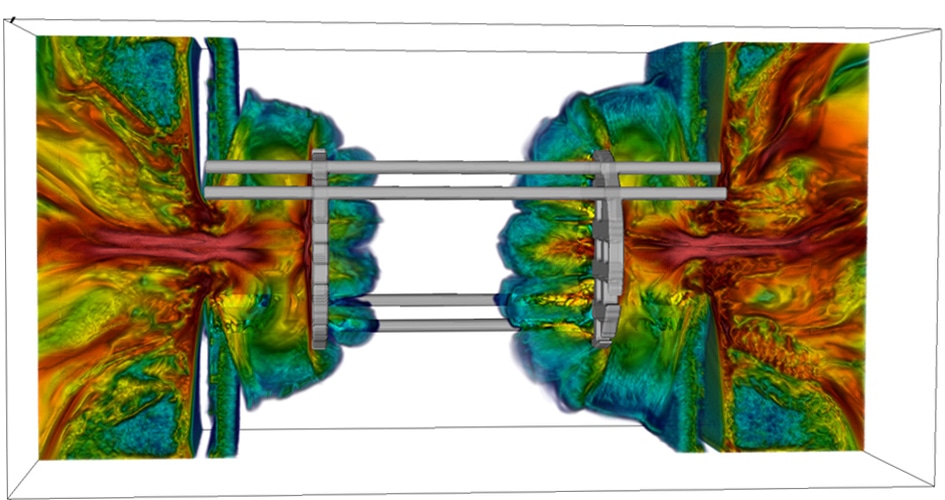Feb 16 2018
Every single thing in the universe, such as stars, planets, and galaxies, produce magnetic fields, making the universe highly magnetic. For a long time, astrophysicists have been perplexed by these astonishingly long-lived and strong fields, with hypotheses and simulations searching for a mechanism that could elucidate their production.
 Three-dimensional FLASH simulation of the experimental platform performed on the Mira supercomputer. Shown are renderings of the simulated magnetic fields before the flows collide. (Image credit: The Flash Center for Computational Science)
Three-dimensional FLASH simulation of the experimental platform performed on the Mira supercomputer. Shown are renderings of the simulated magnetic fields before the flows collide. (Image credit: The Flash Center for Computational Science)
A team headed by researchers from the University of Chicago used one of the most robust laser facilities across the globe and experimentally confirmed one of the most famous theories for the generation of a cosmic magnetic field - the turbulent dynamo. The researchers created a hot turbulent plasma with the size of a penny, lasting only a few billionths of 1 second, and recorded the way the turbulent motions amplified a weak magnetic field to the power of those noticed in our sun, distant galaxies and stars.
The paper was published in Nature Communications journal this week and is the first ever lab demonstration of a theory elucidating the magnetic field of many cosmic bodies, discussed by physicists for close to a century. The team used the FLASH physics simulation code—developed by the Flash Center for Computational Science at UChicago—to design an experiment performed at the OMEGA Laser Facility in Rochester, New York, to recreate turbulent dynamo conditions.
The experiment confirmed numerical simulations performed over several decades by showing that turbulent plasma can drastically amplify a weak magnetic field to the magnitude noticed by astronomers in galaxies and stars.
We now know for sure that turbulent dynamo exists and that it’s one of the mechanisms that can actually explain magnetization of the universe. This is something that we hoped we knew, but now we do.
Petros Tzeferacos, Research Assistant Professor of Astronomy and Astrophysics - University of Chicago, Associate Director - Flash Center
In a mechanical dynamo, electric current is generated by rotating coils through a magnetic field. However, in the field of astrophysics, dynamo theory suggests the opposite: the movement of electrically conducting fluid produces and sustains a magnetic field. In the early 20th century, Joseph Larmor, a physicist, hypothesized that this mechanism could elucidate the magnetism of the sun and Earth, stimulating several decades of scientific discussions and investigation.
Although numerical simulations showed that turbulent plasma could produce magnetic fields at levels of those noticed in planets, stars, and galaxies, developing a turbulent dynamo in the lab was highly challenging. Corroborating the theory mandates the creation of plasma at an exceptionally higher temperature and volatility to generate the adequate turbulence to fold, stretch, and amplify the magnetic field.
To devise an experiment for creating these conditions, Tzeferacos and his team from UChicago and the University of Oxford carried out hundreds of two-dimensional and three-dimensional simulations with FLASH on the Mira supercomputer at Argonne National Laboratory. The final experimental framework involved exploding two penny-sized pieces of foil with robust lasers, driving two plasma jets through grids to collide with one another, generating turbulent fluid motion.
People have dreamed of doing this experiment with lasers for a long time, but it really took the ingenuity of this team to make this happen. This is a huge breakthrough.
Donald Lamb, the Robert A. Millikan Distinguished Service Professor Emeritus in Astronomy and Astrophysics and Director of the Flash Center
The researchers also adopted FLASH simulations to create two independent techniques for evaluating the magnetic field generated by the plasma—proton radiography, the topic of the latest paper from the FLASH group; and polarized light, dependent on how astronomers evaluate the magnetic fields of faraway objects. Both evaluations tracked the growth of the magnetic field within a few nanoseconds from its initial weaker state to more than 100 kG—powerful than a high-resolution MRI scanner and over a million times robust than Earth’s magnetic field.
This work opens up the opportunity to experimentally verify ideas and concepts about the origin of magnetic fields in the universe that have been proposed and studied theoretically over the better part of a century
Fausto Cattaneo, Co-Author and Professor of Astronomy and Astrophysics -University of Chicago.
As a turbulent dynamo can now be generated in a laboratory, researchers can investigate intense questions related to its function: How rapidly does the strength of the magnetic field increase? How powerful can the field grow? What is the change that the magnetic field brings to the turbulence amplifying it?
“It’s one thing to have well-developed theories, but it’s another thing to really demonstrate it in a controlled laboratory setting where you can make all these kinds of measurements about what’s going on,” stated Lamb. “Now that we can do it, we can poke it and probe it.”
Apart from Tzeferacos and Lamb, UChicago co-authors on the paper are Carlo Graziani and Gianluca Gregori, who is also a Professor of Physics at the University of Oxford. The European Research Council and the U.S. Department of Energy funded the study.